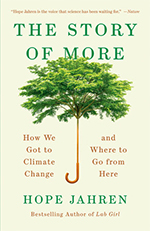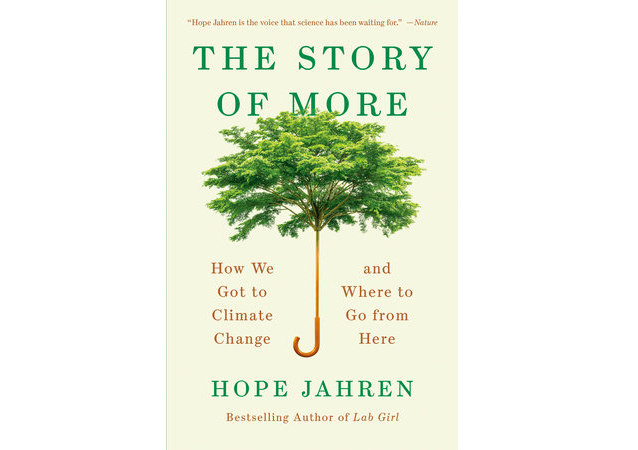 Humanity faces a crisis today, and we struggle to find the right way to deal with it, to solve it, to live meaningfully within the constraints it imposes. You might think I’m referring to coronavirus, but it’s actually climate change that’s on my mind. Hope Jahren, author of the incandescent Lab Girl, has a new volume out, on the unsustainability of modern Western life, and what actions we can take as individuals to lessen our negative impact on the global environment while simultaneously living richer, more thoughtful lives. It’s called The Story of More (more people, more energy, more resources, more carbon dioxide, etc.) with the subtitle of “How We Got to Climate Change, and Where to Go from Here.” Apparently derived from a university-level course on climate change that Jahren teaches, this book is more relentlessly quantitative than the deeply personal stories told in Lab Girl, but each chapter includes some tale from Jahren’s life that illustrates some connection to the topic in question. These vary between extremely apt and peripheral, but they are invariably heartfelt and poignant. Her writing, as always, is exceptionally elegant. One example of this is her description of a petroleum refinery south of New Orleans: It’s “a bizarre landscape that looks to have been co-designed by Ayn Rand and Aldous Huxley. For a full five miles along the road next to Chalmette, Louisiana, you’ll pass a massive array of smokestacks, steamstacks, and chimneys, looped together with pipes and shutoff valves, more angular than a Dr. Seuss drawing but equally fantastic.” The focus is always on the human connection, and never delves into remote, inhuman topics like atmospheric dynamics. A lot of it is about food and eating, nurturing plants that they may nurture us. It feels very grounded and profound as a result. I’d imagine that for Jahren’s lucky students, this intimate sense of our own deep connections with the wider world comes through in classroom discussions. In communicating, Jahren exhibits a disciplined love of words and allusions, connections and analogies. She impresses her perspective with countless calculations that she has performed herself from a diverse suite of data sources (an extended appendix to the book reviews these sources, enabling readers to explore the numbers on their own). All told, the book doesn’t “land” emotionally with the same intensity as Lab Girl, but it’s less of a memoir and more of a “personal textbook.” I could very easily imagine this volume as one of a triad of readers for an Environmental Geology course: Along with John McPhee’s The Control of Nature and Elizabeth Kolbert’s The Sixth Extinction, The Story of More would serve there to round out an understanding of the human relationship to nature with an emphasis on personal opportunity and responsibility. Recommended, particularly the audiobook, which Jahren herself reads at perfect pace and with vital emphasis.
Humanity faces a crisis today, and we struggle to find the right way to deal with it, to solve it, to live meaningfully within the constraints it imposes. You might think I’m referring to coronavirus, but it’s actually climate change that’s on my mind. Hope Jahren, author of the incandescent Lab Girl, has a new volume out, on the unsustainability of modern Western life, and what actions we can take as individuals to lessen our negative impact on the global environment while simultaneously living richer, more thoughtful lives. It’s called The Story of More (more people, more energy, more resources, more carbon dioxide, etc.) with the subtitle of “How We Got to Climate Change, and Where to Go from Here.” Apparently derived from a university-level course on climate change that Jahren teaches, this book is more relentlessly quantitative than the deeply personal stories told in Lab Girl, but each chapter includes some tale from Jahren’s life that illustrates some connection to the topic in question. These vary between extremely apt and peripheral, but they are invariably heartfelt and poignant. Her writing, as always, is exceptionally elegant. One example of this is her description of a petroleum refinery south of New Orleans: It’s “a bizarre landscape that looks to have been co-designed by Ayn Rand and Aldous Huxley. For a full five miles along the road next to Chalmette, Louisiana, you’ll pass a massive array of smokestacks, steamstacks, and chimneys, looped together with pipes and shutoff valves, more angular than a Dr. Seuss drawing but equally fantastic.” The focus is always on the human connection, and never delves into remote, inhuman topics like atmospheric dynamics. A lot of it is about food and eating, nurturing plants that they may nurture us. It feels very grounded and profound as a result. I’d imagine that for Jahren’s lucky students, this intimate sense of our own deep connections with the wider world comes through in classroom discussions. In communicating, Jahren exhibits a disciplined love of words and allusions, connections and analogies. She impresses her perspective with countless calculations that she has performed herself from a diverse suite of data sources (an extended appendix to the book reviews these sources, enabling readers to explore the numbers on their own). All told, the book doesn’t “land” emotionally with the same intensity as Lab Girl, but it’s less of a memoir and more of a “personal textbook.” I could very easily imagine this volume as one of a triad of readers for an Environmental Geology course: Along with John McPhee’s The Control of Nature and Elizabeth Kolbert’s The Sixth Extinction, The Story of More would serve there to round out an understanding of the human relationship to nature with an emphasis on personal opportunity and responsibility. Recommended, particularly the audiobook, which Jahren herself reads at perfect pace and with vital emphasis.

